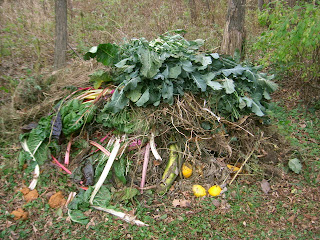Composting to Benefit Farmers and the Environment in Guyana
Compost – decomposed organic material that is recycled as a soil supplement or fertilizer – is increasingly used in organic gardening and agriculture because of its economic and environmental benefits. Compost is created by combining organic wastes such as food scraps, yard trimmings and manure in proper ratios into piles or vessels and adding additional “ingredients” to facilitate the breakdown of the mixture. By manipulating the pile to produce high temperatures, pathogens and weed seeds are destroyed, and the mixture stabilizes to form mature compost; at this point, it can be added to soil to boost nutrient content and fuel plant growth. The benefits of creating compost, or “composting”, include: low cost; improves moisture and nutrient content of soil, promoting increased crop yield; replaces chemical fertilizers; diverts household/industrial wastes from the garbage can and, eventually, landfills.
In Guyana,South America, individual vegetable producers, farms, agricultural organizations, and universities recognize the benefits of composting and have collaborated with F2F to increase their knowledge of how it works, how to improve existing systems, or how to get started. In March 2013, F2F volunteer Rhonda Sherman of North Carolina traveled to Guyana to provide instruction to farmers, students and staff at the Guyana School of Agriculture (GSA), and the public on composting and vermicomposting – using worms to turn organic wastes into compost. Ms. Sherman, Extension Specialist in Solid Waste Management at North Carolina State University, sought to enable participants to better manage existing composting systems or begin backyard systems of their own. Over 100 individuals attended Ms. Sherman’s training sessions, which were broadly advertised by local media houses.
Three workshops on mid-scale composting and vermicomposting were held for farmers and staff at St. Stanislaus College Farm (SSCF) in Georgetown and for staff and students at GSA. Topics included: compost mixing and pile formation; curing, storage and handling; and recovering un-composted material from finished compost.

Ms. Sherman also evaluated existing composting and vermicomposting operations at St. Stanislaus College
Farm (SSCF) in Georgetown, GSA, and the National Agriculture
Research and Extension Institute (NAREI). Another 2 sessions were held for the general public on the benefits of composting, how it works, and basic steps to begin. Following Ms. Sherman’s departure, F2F Field Officers led an additional training session due to continued requests.
SSCF, GSA, and individual producers have begun to implement several of Ms. Sherman’s recommendations regarding compost pile composition, size, placement, temperature, and mixing frequency. She was featured in multiple local newspapers – Stabroek News, Guyana Chronicle, Guyana Times – to help spread information about composting and related topics. In addition, Ms. Sherman continues to receive emails from individuals who want to compost at their homes and entrepreneurs who want to establish municipal composting sites to process organic residuals from markets and yard waste.
Three workshops on mid-scale composting and vermicomposting were held for farmers and staff at St. Stanislaus College Farm (SSCF) in Georgetown and for staff and students at GSA. Topics included: compost mixing and pile formation; curing, storage and handling; and recovering un-composted material from finished compost.

Ms. Sherman also evaluated existing composting and vermicomposting operations at St. Stanislaus College
Farm (SSCF) in Georgetown, GSA, and the National Agriculture
Research and Extension Institute (NAREI). Another 2 sessions were held for the general public on the benefits of composting, how it works, and basic steps to begin. Following Ms. Sherman’s departure, F2F Field Officers led an additional training session due to continued requests.
SSCF, GSA, and individual producers have begun to implement several of Ms. Sherman’s recommendations regarding compost pile composition, size, placement, temperature, and mixing frequency. She was featured in multiple local newspapers – Stabroek News, Guyana Chronicle, Guyana Times – to help spread information about composting and related topics. In addition, Ms. Sherman continues to receive emails from individuals who want to compost at their homes and entrepreneurs who want to establish municipal composting sites to process organic residuals from markets and yard waste.


.png)

Comments
Post a Comment